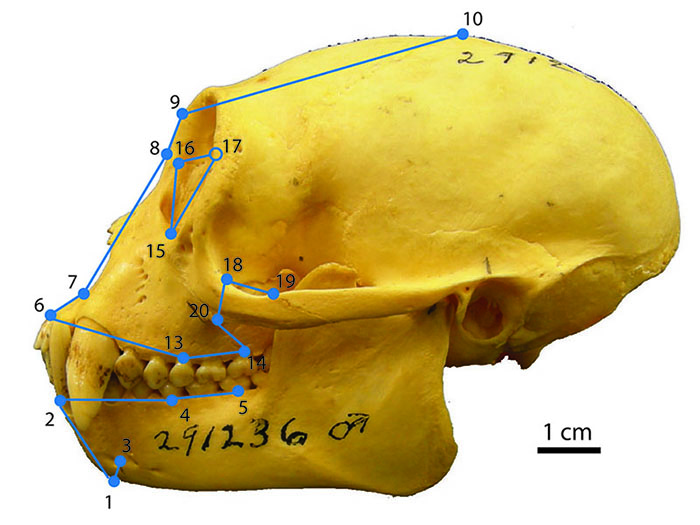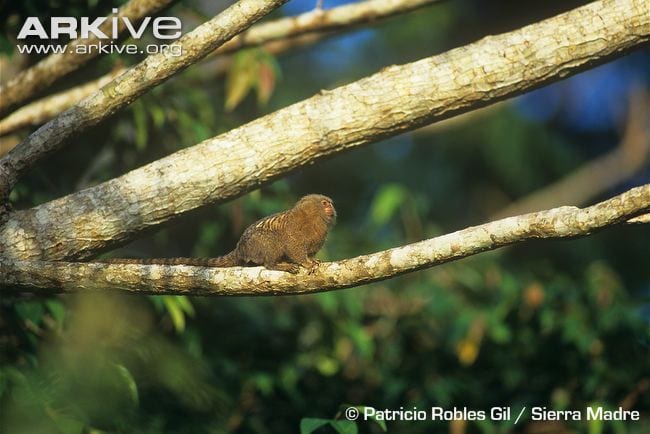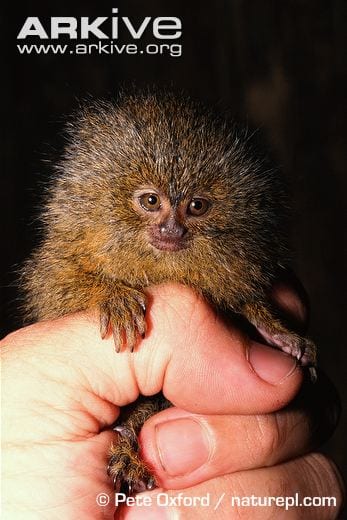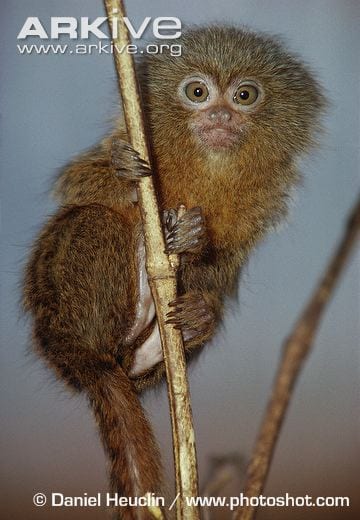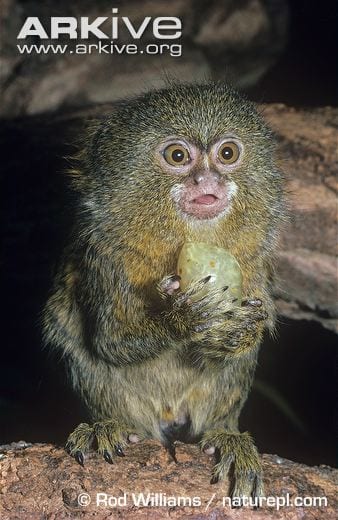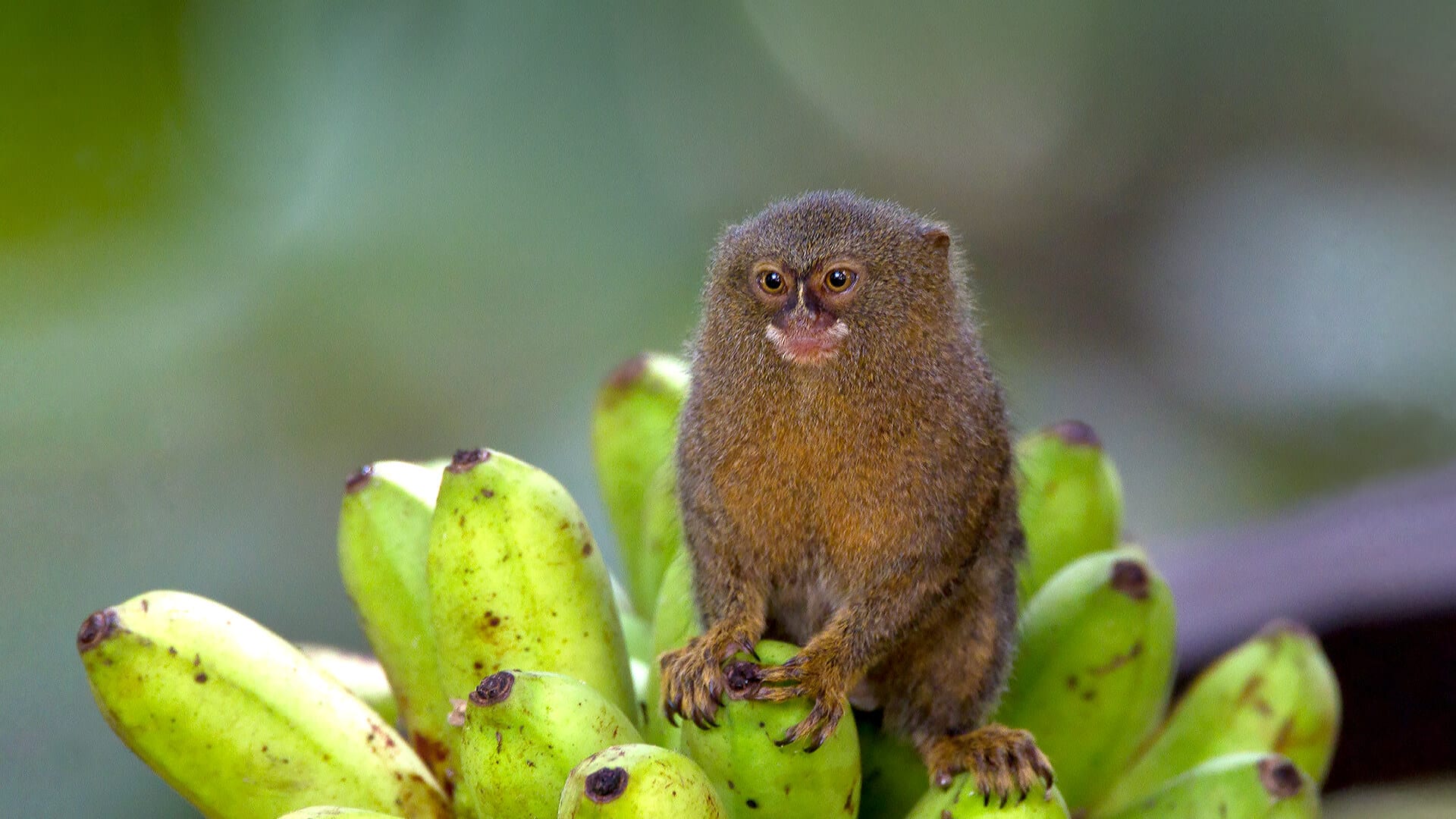A new school year is starting in the US, so we’re hoping this month’s peculiar primate will help you get ready and excited to learn. As requested, this month’s post is about the pygmy marmoset (Cebuella pygmaea). This little one is the smallest monkey in the world, but not quite the smallest primate. So first, let’s get some terminology straight. “Monkey” most commonly refers to New World (North and South American) primates and Old World (European, Asian, African) non-apes, both extinct (or dead) groups, and extant (or living) groups. The ape group includes gibbons, orangutans, gorillas, chimpanzees, and humans. The term “primate” is actually an order in the Linnaean classification system. Think kingdom, phylum, class, order, family, genus, species, and the hundreds of terms in between those levels. So, the term primate actually refers to any species in the primate order, that is, all monkeys, apes, lemurs, and lorises.
Pygmy marmoset on branch – Photo from ARKive
Now that we understand what we’re talking about a little better, let’s get to it. As the smallest monkey, the pygmy marmoset weighs only about 1/4 to 1/3 of a pound; it’s tiny compared to its other marmoset relatives (1). This weight is about the same as four roses, which have about as much to do with pygmy marmosets as what you had for lunch yesterday. Because it is the smallest monkey in the world, but not the smallest primate, that means there is a primate even smaller. I know, crazy, right?! In fact, the mouse lemur from Madagascar is smaller. We’ll be sure to talk about that one in the future.
Pygmy marmoset in hand – Photo from ARKive
The pygmy marmoset is a South American primate that is closely related to our emperor tamarin, which I wrote about previously. They are both in the Callitrichidae family. Like the emperor tamarins, pygmy marmosets usually births twins and have claw-like nails, called tegulae. Pygmy marmosets and the other primates in their family have tegulae because they need a bit of extra help holding onto tree branches due to their small size (1,2). Female pygmy marmosets also tend to be slightly larger than males, a rare trait for many primates, and is probably related to the fact that breeding groups consist of one dominant female and multiple males (1,2).
Juvenile pygmy marmoset – Photo from ARKive
Juvenile pygmy marmoset eating a grape – Photo from ARKive
Pygmy marmosets are native to Bolivia, Brazil, Colombia, Ecuador and Peru and live in the trees in small groups of about two to six that consist of family members (2). These primates feast on gums/exudates, otherwise known as tree sap, but also occasionally eat fruit, small lizards, and flowers (2). The home range (that is, the total area a primate occupies) of pygmy marmosets is quite small, because they are the smallest monkey in the world and, as it turns out, trees are quite big (3). They mostly stick to two or three main trees and occasionally venture away when they’ve exhausted the food supply in their area.
Pygmy marmoset sitting on bananas – Photo from San Diego Zoo
This primate is not endangered, but the pet trade is a major concern for pygmy marmosets (3). Always remember that wild animals should not be kept as pets, especially primates! Opt for a domesticated animal like a dog or cat, and we think you’ll have a much more enjoyable pet experience. Watch the video below for information about Ninita and pygmy marmoset conservation.
We hope you’ve enjoyed this installment of Peculiar Primates! Look at our references below, or email Ashly Romero at anromero@uark.edu for more information.
References:
- ARKive – Pygmy Marmoset (Cebuella pygmaea). Retrieved from http://www.arkive.org/pygmy-marmoset/cebuella-pygmaea/image-G26903.html in August 2018.
- Animal Diversity Web – Callithrix pygmaea. Retrieved from https://animaldiversity.org/accounts/Callithrix_pygmaea/#food_habits in August 2018.
- IUCN RedList – Cebuella pygmaea. Retrieved from http://www.iucnredlist.org/details/41535/0 in August 2018.
